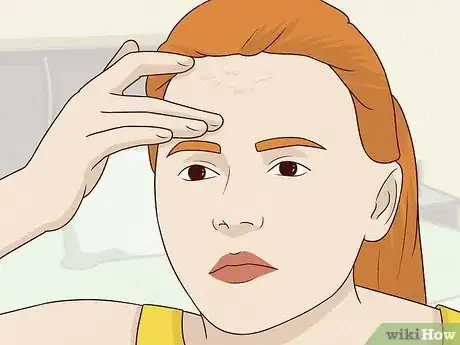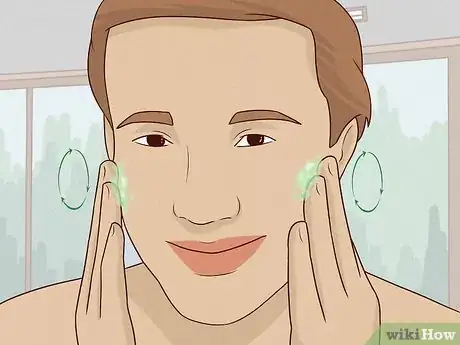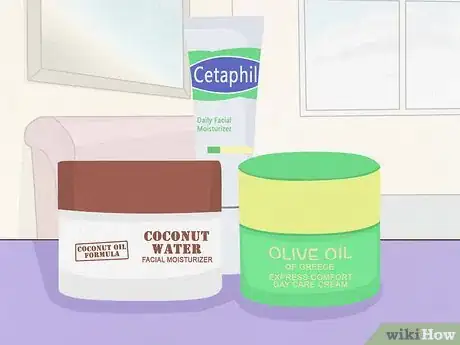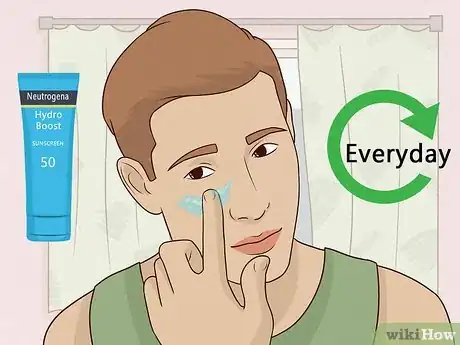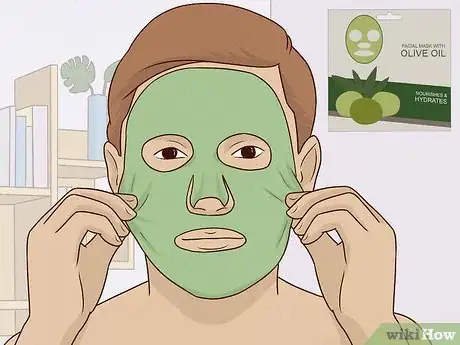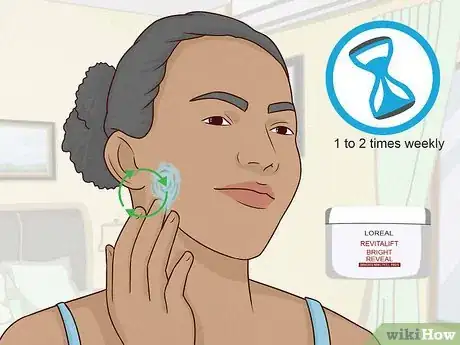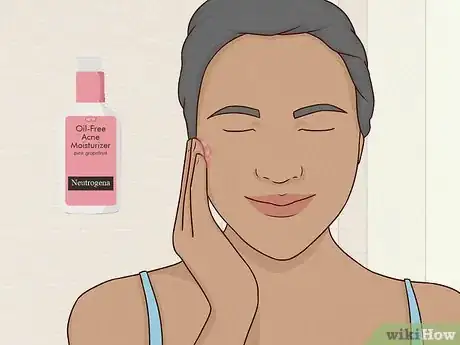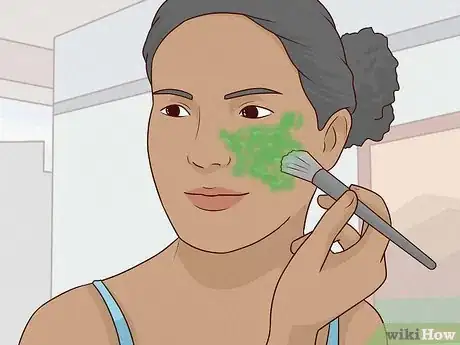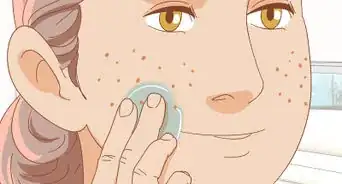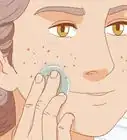This article was co-authored by Kaveri Karhade, MD. Dr. Kaveri Karhade is a board certified Laser, Medical, and Cosmetic Dermatologist in the San Francisco Bay Area. Her areas of expertise are acne and hair loss. She has advanced training in injectables, lasers, surgery, and other cosmetic treatments, and has published extensive research in medical journals. She holds a BS from Michigan State University and a Doctor of Medicine (MD) from the University of Michigan Medical School. She completed her internship in Internal Medicine at New York University School of Medicine and her Residency in Dermatology at Brown University School of Medicine. Dr. Karhade is a fellow of the American Academy of Dermatology and a member of the American Society for Dermatologic Surgery.
There are 13 references cited in this article, which can be found at the bottom of the page.
This article has been viewed 154,380 times.
Moisturizing your face is one of the most important steps in your skincare routine. It keeps your skin hydrated, helps regulate your oil production, and leaves you with smoother, softer skin. But how often should you moisturize your face, and what kind of moisturizer should you be using? Don't worry—in this article, we'll walk you through everything you need to know when it comes to moisturizing your face, whether you have dry, oily, or combo skin.
Steps
Identifying Skin Type
-
1Identify normal skin by a lack of imperfections. Normal skin is not too oily or too dry. If you have normal skin, your pores are likely barely visible and you rarely have breakouts, irritation, or sensitivity to skincare products. Your complexion likely looks radiant and clear if you have normal skin.[1]
- You won’t need any specialized treatment if you have normal skin, but you should still apply a moisturizer daily after cleansing.[2]
-
2Notice the symptoms of dry skin. When you have dry skin on your face, it feels dry and perhaps even stiff when you move your face's muscles quickly or try stretching your face. Your dry facial skin may look flakey or like it needs to peel on occasion. Your dry skin might form cracks that bleed. It may also look noticeably like it needs hydration or moisturizing.
- Many people get more severe dry skin in the winter because of the climate change.
- The surface of your skin may also appear dull and you may have visible fine lines if your skin is dry.
Advertisement -
3Recognize if you have oily skin. Immediately after you wash your face, oily skin won't stay matte for long. It gets shiny again very quickly. Your face will shine because of the oil produced on the surface of your skin, and your pores will be easily visible across the center of your face. There will likely be many breakouts on your face if you have oily skin.
- Oily skin is more common in younger people. Skin typically gets more dried out as we age.
-
4Determine if you have a combination skin type. If your face is oily in the T-zone (the area of your nose, between your eyes and eyebrows, and forehead only) but everywhere else is dry, you probably have combination-type skin.[3]
- If you have combination skin, then you will need to moisturize the different areas of your face appropriately. Follow guidelines for oily skin for your T-zone and follow guidelines for dry skin for the rest of your face.
- Combination skin usually involves pores that look larger than normal because they are more open. This can also lead to more frequent breakouts.
Dry Skin
-
1Avoid washing your dry face too often. Frequent washing will cause your face to dry out even more. Additional water will not add hydration. When washing the face, it is best if you wash your face with warm water.[4]
- When showering or washing your face, use warm or lukewarm water instead of hot water.
- Use a gentle cleanser that is fragrance-free.
- Try using a micellar solution to remove makeup and dirt if you want to cleanse your face without water.
- Avoid using hot or cold water when washing your face. Exposing the skin on your face to these extreme temperatures can cause excess dryness, irritation, or even rupture blood vessels.[5]
-
2Exfoliate using a gentle chemical exfoliant. Avoid using an exfoliant with rough bits in it, such as nut shells and sugar. Instead, opt for something gentle, such as a chemical exfoliant. This will help remove dead, dry skin cells and reveal the smoother, softer skin underneath.[6] Use small, circular motions when you apply the product to your skin. Rinse the product off thoroughly with lukewarm water and pat your skin dry.[7]
- Apply your moisturizer after you finish exfoliating.[8]
- Only exfoliate once or twice per week.
-
3Use moisturizing cream labeled for dry skin. Start using a moisturizer product that is labeled "for dry to very dry skin." If you think that your skin is only a little dry, pick the product that is labeled "for normal to dry skin." Opt for a lightweight moisturizer during the day and a heavier moisturizer at night, such as an intensive moisturizer.[9]
- If you want to use a natural ingredient, use an oil, such as olive oil or coconut oil.
- You should also look for moisturizers with ingredients that are beneficial to dry skin, such as olive oil, jojoba oil, shea butter, urea, lactic acid, hyaluronic acid, dimethicone, lanolin, glycerin, petrolatum, and mineral oil.[10]
- A cream is better for dry skin than a lotion because it contains more oil and is, therefore, better at locking in moisture and helping to hydrate dry skin.
-
4Apply moisturizer directly after washing your face. It is important to apply your moisturizer immediately after washing your face so that the cream can help hold in any added moisture remaining from washing your face. Apply evenly and leave it for few minutes, until your face feels more hydrated. After this, you can apply your makeup.[11]
- Do not apply too much, as this is a waste of product; adding more doesn't do more.
-
5Apply sunscreen daily. A hydrating sunscreen that is broad spectrum (protects from both UVA and UVB rays) will protect you from burns and sun damage that ages the skin and will also prevent skin from drying out further.
- Apply sunscreen as your morning moisturizer. You shouldn't need more than that, but if you want to supplement with an additional moisturizer, apply the SPF first. Wait a few minutes and allow it to dry, then apply the moisturizer on top.
-
6Use a face mask. Facial masks can treat all kinds of skin issues, including dry skin. For dry skin, do this no more than twice a month. To combat dry skin, you’ll want to use a facial mask that contains one of the following:
- Olive oil
- Argan oil
- Coconut oil
- Honey
- Egg yolk
- Carrot
- Tomato
Oily Skin
-
1Wash your face 2 times daily. If you have oily skin, you should wash your face a little more often than people with dry skin. It is recommended that you wash your face twice a day with a cleansing soap. However, don’t wash your face more than this or you may make your oily skin worse. Don't use hot water or steam to clean your face, as this removes essential fatty acids from your skin.[12]
- And since oily skin is the easiest type of skin for acne to emerge on (owing to the excessive oil that is trapped inside the pores), it is better to have a cleansing face soap that contains tea tree oil/lemon/salicylic acid.
- Over-washing can dry your skin, which can actually cause it to produce more oil to compensate.
-
2Exfoliate your skin 1 to 2 times weekly. Choose a chemical exfoliator that is meant for oily skin. Apply the product with small, circular motions, and then rinse it away with lukewarm water. Pat your skin dry and apply your moisturizer when you’re done.[13]
- Avoid using mechanical exfoliants which often contain nutshells and other potentially irritating ingredients. Stick with chemical exfoliants for a gentler option.
-
3Use a moisturizing lotion intended for oily skin. Look for a moisturizer labeled "for oily to normal skin." Having an oily face does not mean you shouldn't use a moisturizer; it just needs to be a suitable moisturizer. Only use a water-based products though; you don't want to add more oil.[14]
- A lotion is better for oily skin because it doesn’t contain the extra oils found in moisturizing creams.
- While some recommend using various types of oil to cleanse faces with an oily skin type, most experts say that this method can do more harm than good — often leading to breakouts and other types of skin damage.[15]
-
4Remember to apply sunscreen. To protect your skin and prevent sun damage and burns, you want to make sure you wear a sunscreen every day. If your skin is oily, look for an oil-free preparation made specifically for use on your face.[16]
-
5Improve your face's appearance by using a face mask. Regularly using a face mask/exfoliating mask will help to make your skin feel better. For oily skin, use this treatment method less than twice a week. You can use either mask products or a DIY mask; both can be really helpful.
- For more information, check out How to Make All Natural Face Masks.
- For oily skin, use a mask that contains one of the following: lemon, avocado, egg whites, cucumber, or milk.
Expert Q&A
Did you know you can get expert answers for this article?
Unlock expert answers by supporting wikiHow
-
QuestionHow do I make my face feel softer?
 Kaveri Karhade, MDDr. Kaveri Karhade is a board certified Laser, Medical, and Cosmetic Dermatologist in the San Francisco Bay Area. Her areas of expertise are acne and hair loss. She has advanced training in injectables, lasers, surgery, and other cosmetic treatments, and has published extensive research in medical journals. She holds a BS from Michigan State University and a Doctor of Medicine (MD) from the University of Michigan Medical School. She completed her internship in Internal Medicine at New York University School of Medicine and her Residency in Dermatology at Brown University School of Medicine. Dr. Karhade is a fellow of the American Academy of Dermatology and a member of the American Society for Dermatologic Surgery.
Kaveri Karhade, MDDr. Kaveri Karhade is a board certified Laser, Medical, and Cosmetic Dermatologist in the San Francisco Bay Area. Her areas of expertise are acne and hair loss. She has advanced training in injectables, lasers, surgery, and other cosmetic treatments, and has published extensive research in medical journals. She holds a BS from Michigan State University and a Doctor of Medicine (MD) from the University of Michigan Medical School. She completed her internship in Internal Medicine at New York University School of Medicine and her Residency in Dermatology at Brown University School of Medicine. Dr. Karhade is a fellow of the American Academy of Dermatology and a member of the American Society for Dermatologic Surgery.
Board Certified Dermatologist
-
QuestionIs it important to moisturize your face at night?
 Laura MartinLaura Martin is a Licensed Cosmetologist in Georgia. She has been a hair stylist since 2007 and a cosmetology teacher since 2013.
Laura MartinLaura Martin is a Licensed Cosmetologist in Georgia. She has been a hair stylist since 2007 and a cosmetology teacher since 2013.
Licensed Cosmetologist
-
QuestionCan you put too much moisturizer on your face?
 Laura MartinLaura Martin is a Licensed Cosmetologist in Georgia. She has been a hair stylist since 2007 and a cosmetology teacher since 2013.
Laura MartinLaura Martin is a Licensed Cosmetologist in Georgia. She has been a hair stylist since 2007 and a cosmetology teacher since 2013.
Licensed Cosmetologist
References
- ↑ https://www.webmd.com/beauty/whats-your-skin-type
- ↑ Joanna Kula. Skincare Specialist. Expert Interview.9 July 2019.
- ↑ http://www.paulaschoice.com/expert-advice/combination-skin/_/combination-skin-how-it-works
- ↑ https://www.aad.org/public/skin-hair-nails/skin-care/dry-skin
- ↑ http://www.brit.co/how-to-really-wash-your-face/
- ↑ Joanna Kula. Skincare Specialist. Expert Interview.9 July 2019.
- ↑ https://www.aad.org/public/skin-hair-nails/skin-care/exfoliation
- ↑ Joanna Kula. Skincare Specialist. Expert Interview.9 July 2019.
- ↑ http://www.newhealthguide.org/Home-Remedies-For-Dry-Skin-On-Face.html
- ↑ https://www.aad.org/public/skin-hair-nails/skin-care/dry-skin
- ↑ http://www.huffingtonpost.com/2014/02/04/how-to-moisturize-your-face_n_4704301.html
- ↑ http://www.cosmopolitan.com/style-beauty/beauty/a49381/oily-skincare-tips/
- ↑ https://www.aad.org/public/skin-hair-nails/skin-care/exfoliation
- ↑ http://www.marieclaire.co.uk/beauty/best/13989/moisturiser-for-oily-skin.html
- ↑ http://www.paulaschoice.com/expert-advice/oily-skin/_/very-oily-skin
- ↑ http://www.huffingtonpost.com/2014/02/04/how-to-moisturize-your-face_n_4704301.html
- ↑ http://www.skincancer.org/prevention/uva-and-uvb
- ↑ http://www.huffingtonpost.com/2014/02/04/how-to-moisturize-your-face_n_4704301.html
- ↑ Joanna Kula. Skincare Specialist. Expert Interview.9 July 2019.
About This Article
To moisturize your face, use a moisturizing cream or a natural oil, like olive oil, if you have dry skin. If you have oily skin, use a water-based moisturizing lotion on your face so you don't make your skin more oily. Regardless of your skin type, always wash your face before applying moisturizer. Wash your face multiple times a day if you have oily skin, or just wash your face twice a day if you have dry skin so you don't dry it out more. To learn how to determine what kind of skin you have, keep reading!


